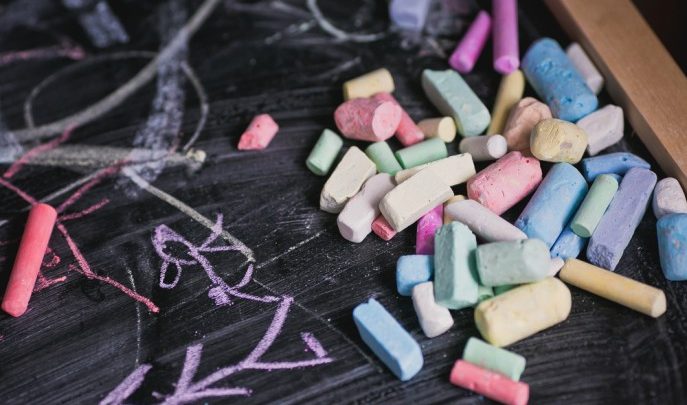Creating The Ideal Environment For Mark Making To Flourish

It's not just about early writing; it is a sensory and physical experience enjoyed by all ages and abilities

Children start to make marks from the time they can control the movements of their hands and feet, whether that is swishing food around on their tray or picking up a crayon, pressing it down and watching colour appear on the nearest clean surface.
These children will go on to make marks that become pictures, writing, numbers and symbols representing and making sense of their world. It is a natural process. They will start to notice signs, numbers on buses, an adult writing a list and understand that these symbols carry meaning.
At PACEY we believe that mark making in all forms needs to be valued, encouraged and discussed. Making marks is enjoyable for the process itself; often children are not thinking of the end product, they are exploring with their senses, developing confidence and dexterity.
Children learn and express so many different things from making marks, observe their process and listen carefully, they often talk freely about the marks they are making. It’s an invaluable form of communication and a great way for a child to express themselves. It can really help children to investigate a new concept, represent thoughts and ideas, develop their understanding of the world, tell stories, problem solve and record memories.
With so many benefits and outcomes for mark making, it is important to recognise all the different forms it can come in, and to facilitate an environment which encourages and values it for children of all ages and abilities.
Valuing mark making
It is vital that early years practitioners value mark making and representation in your setting by talking about the work the children are doing as well as displaying the final product.
By describing what you see the children doing; the colours they use; the lines they make, as well as asking sensitive, open-ended questions it will help to get them to extend their thinking.
For example, if they tell you they’re drawing or making a rocket, ask where the rocket is going, how high, how fast, and watch the impact those questions have on their thoughts and their creation.
Value mark making done at home, and think about how you can value the start of mathematical representation just as much as art or writing.
Exploring mark making and media
Mark making can take place using many different media and in many different forms.
There are lots of opportunities for mark making outside, from drawing with sticks in mud to messy play with cornflour and water, clay, sand, soil shaving foam, and paint.
In fact, the natural world provides lots of inspiration for mark making, with leaf and bark rubbing, flower pressing and creations using fir cones and seed pods.
Varying the size, colour and texture of paper can make a difference to mark making experiences, with very large paper giving active children room to spread out, explore and collaborate. Cutting and sticking is also another way that children can make their mark.
There are plenty of chances for mark making and representation within role-play situations. For example, during travel role play, the children can draw maps, roads, homes and give directions. Also, to encourage mathematical mark making, make available calendars, raffle tickets, recipes and petty cash receipts.
As children shift from making their own meanings in their work to making marks that others can understand (for example alphabet, numbers, and representational drawings) the view and role of the adult becomes increasingly important. You need to listen to children and respond to what they are doing, understanding that they can teach us and give their own marks meaning. Any marks on paper may be given meaning.
Share with them the importance of print, that words on food packets and street signs as well as number and letters on car registrations and buses all carry meaning. Support children to be aware of these marks, work towards understanding them, and then to make their own marks and to experiment freely.
Technology can also be used for mark making with paint and word processing programmes on computers, drawing apps on tablets, and photographs which can be used to make books and stories later. Photocopiers, scanners and whiteboards can be useful tools too.
Supporting the curriculum
Mark making supports many areas of learning beginning with physical development and the co-ordination of large and small movements. Literacy, maths and of course creative subjects can be evidenced in mark-making activities.
An enabling environment
Talking with children before they draw, paint, write or make marks can help some of them put their thoughts in order. Help them develop their thinking by asking sensitive open-ended questions.
Creating an enabling environment is also the adult’s role, as is providing a positive role model – let the children see you write, draw, paint and make marks. Have mark-making materials in all areas of your setting including outside.
But most importantly, when you’re thinking about mark making in your early years setting, ensure an inclusive approach. Giving children the chance to express themselves without the fear of not being good at drawing or writing, or not being able to represent an idea in the way they want to, is vital. The importance of mark making should not be underestimated.
For further information about PACEY visit pacey.org.uk, and for ideas, inspiration and resources read more in this great blog on supporting child-led art activities and check out these links that are available for PACEY members: • Mark-making factsheet • Mark making and representation practice guide • Guest blog on messy creativity • Firework mark making • Leaf printing
Theresa Johnson is training and development manager for the Professional Association for Childcare and Early Years (PACEY)











